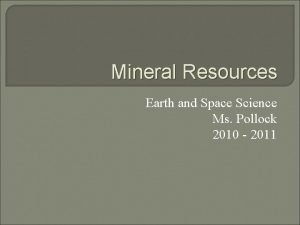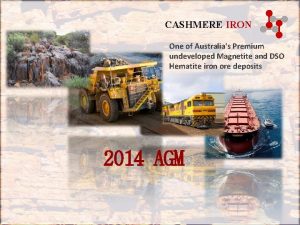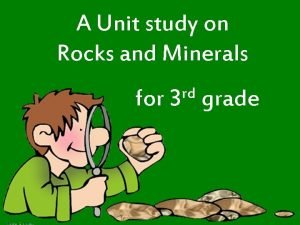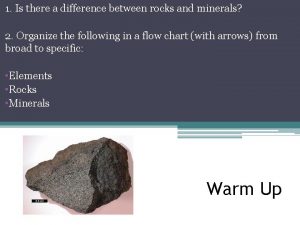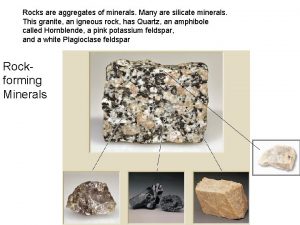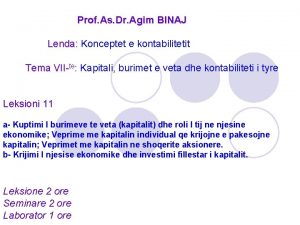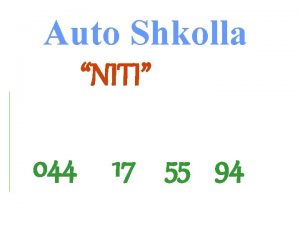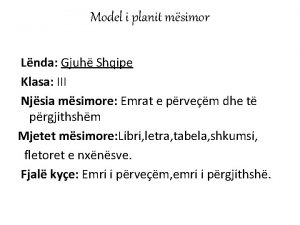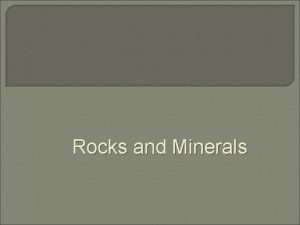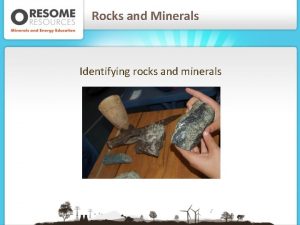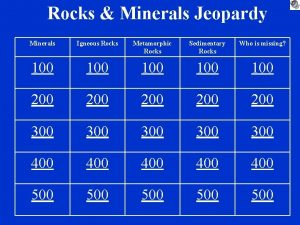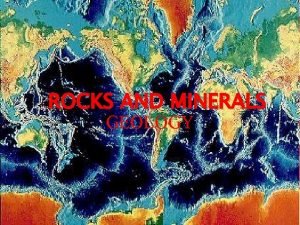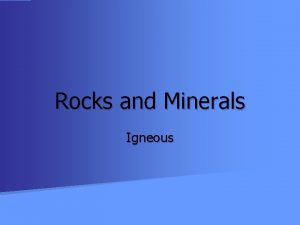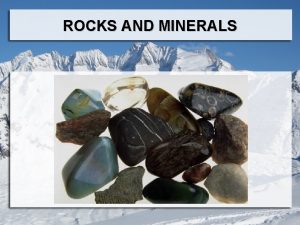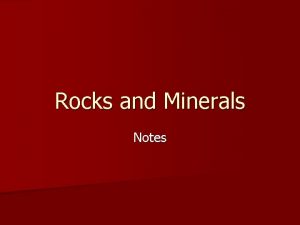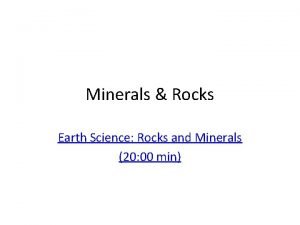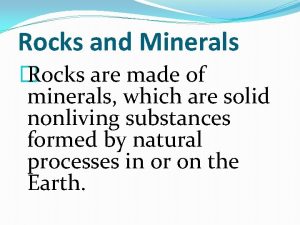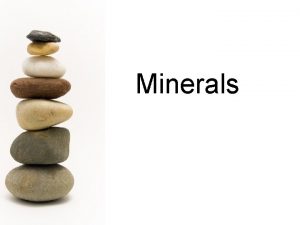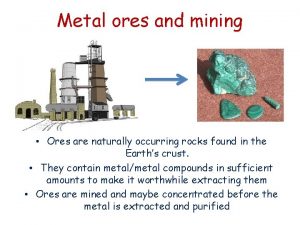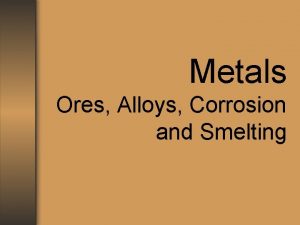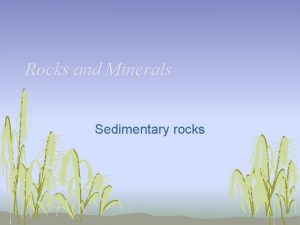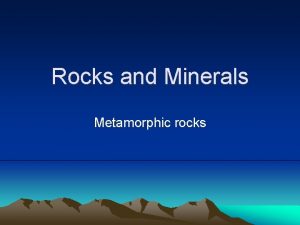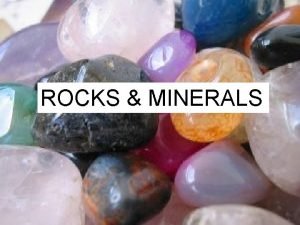IRON ORE Iron ores are rocks and minerals






















- Slides: 22

IRON ORE

• Iron ores are rocks and minerals from which metallic iron can be economically extracted. • The ores are usually rich in iron oxides and vary in color from dark grey, bright yellow, deep purple, to rusty red. The iron itself is usually found in the form of magnetite (Fe 3 O 4), hematite(Fe 2 O 3), goethite (Fe. O(OH)), limonite (Fe. O(OH). n(H 2 O)) or siderite (Fe. CO 3). • Hematite is also known as "natural ore", a name which refers to the early years of mining, when certain hematite ores containing up to 66% iron could be fed directly into ironmaking blast furnaces. Iron ore is the raw material used to make pig iron, which is one of the main raw materials to make steel. • 98% of the mined iron ore is used to make steel. Indeed, it has been argued that iron ore is "more integral to the global economy than any other commodity, except perhaps oil".

Sources • Metallic iron is virtually unknown on the surface of the Earth except as iron-nickel alloys from meteorites and very rare forms of deep mantlexenoliths. • Although iron is the fourth most abundant element in the Earth's crust, comprising about 5%, the vast majority is bound in silicate or more rarely carbonate minerals. • The thermodynamic barriers to separating pure iron from these minerals are formidable and energy intensive, therefore all sources of iron used by human industry exploit comparatively rarer iron oxide minerals, the primary form which is used being hematite.

• Iron ore mining methods vary by the type of ore being mined. There are four main types of iron ore deposits worked currently, depending on the mineralogy and geology of the ore deposits. These are magnetite, titanomagnetite, massive hematite and pisolitic ironstone deposits.

Hematite: the main iron ore in Brazilian mines

Stockpile of iron ore pellets will be used in steel production.

Processed Taconite pellets as used in the steelmaking industry, with a US Quarter shown for scale

Banded iron formations • Banded iron formations (BIF) are metamorphosed sedimentary rocks composed predominantly of thinly bedded iron minerals and silica (as quartz). • The iron mineral present may be the carbonate siderite, but those used as iron ores contain the oxides magnetite or hematite. • Banded Iron formations are known as taconite within North America. • Mining of BIF formations involves coarse crushing and screening, followed by rough crushing and fine grinding to comminute the ore to the point where the crystallised magnetite and quartz are fine enough that the quartz is left behind when the resultant powder is passed under a magnetic separator.

• • • Currently magnetite iron ore (taconite) is mined in Minnesota and Michigan in the U. S. , and Eastern Canada. Magnetite bearing BIF is currently mined extensively in Brazil, which exports significant quantities to Asia, and there is a nascent and large magnetite iron ore industry in Australia. Magmatic magnetite ore deposits Occasionally granite and ultrapotassic igneous rocks segregate magnetite crystals and form masses of magnetite suitable for economic concentration. A few iron ore deposits, notably in Chile, are formed from volcanic flows containing significant accumulations of magnetite phenocrysts. Chilean magnetite iron ore deposits within the Atacama Desert have also formed alluvial accumulations of magnetite in streams leading from these volcanic formations. Some magnetite skarn and hydrothermal deposits have been worked in the past as high-grade iron ore deposits requiring little beneficiation. There are several granite-associated deposits of this nature in Malaysia and Indonesia. Other sources of magnetite iron ore include metamorphic accumulations of massive magnetite ore such as at Savage River, Tasmania, formed by shearing of ophiolite ultramafics. Another, minor, source of iron ores are magmatic accumulations in layered intrusions which contain a typically titanium-bearing magnetite often with vanadium. These ores form a niche market, with specialty smelters used to recover the iron, titanium and vanadium. These ores are beneficiated essentially similar to banded iron formation ores, but usually are more easily upgraded via crushing and screening. The typical titanomagnetite concentrate grades 57% Fe, 12% Ti and 0. 5% V 2 O 5

Hematite ore • Hematite iron ore deposits are currently exploited on all continents except Antarctica, with the largest intensity in South America, Australia and Asia. Most large hematite iron ore deposits are sourced from altered banded iron formations and rarely igneous accumulations. • Hematite iron is typically rarer than magnetite bearing BIF or other rocks which form its main source or protolith rock, but it is considerably cheaper to process as it generally does not require beneficiation due to its higher iron content. • However, hematite ores are harder than magnetite ores and therefore require considerably more energy to crush and grind if benefication is required. Hematite ores can also contain significantly higher concentrations of penalty elements, typically being higher in phosphorus, water content (especially pisolite sedimentary accumulations) and aluminium (clays within pisolites). • Export grade hematite ores are generally in the 62– 64% Fe range

Production and consumption Estimated iron ore production in million metric tons for 2009 according to U. S. Geological Survey Country Production China 880 Australia 394 Brazil 300 India 245 Russia 92 Ukraine 66 South Africa 55 Iran 33 Canada 32 United States 27 Kazakhstan 22 Sweden 18 Venezuela 15 Mauritania 10 Other countries 43 Total world 2240

World Mine Production and Reserves United States Australia Brazil Canada China India Iran Kazakhstan Mauritania Mexico Russia South Africa Sweden Ukraine Venezuela Other countries World total (rounded) Mine production 2010 2011 e 50 54 433 480 370 390 37 37 1, 070 1, 200 230 240 28 30 24 24 11 11 14 14 101 100 59 55 25 25 78 80 14 16 48 50 2, 590 2, 800 Reserves Crude ore Iron content 6, 900 2, 100 35, 000 17, 000 29, 000 16, 000 6, 300 23, 000 7, 200 7, 000 4, 500 2, 500 1, 400 3, 000 1, 100 700 400 25, 000 14, 000 1, 000 650 3, 500 2, 200 6, 000 2, 100 4, 000 2, 400 12, 000 6, 000 170, 000 80, 000

• Iron is the world's most commonly used metal - steel, of which iron ore is the key ingredient, representing almost 95% of all metal used per year. • It is used primarily in structural engineering applications and in maritime purposes, automobiles, and general industrial applications (machinery). • Iron-rich rocks are common worldwide, but ore-grade commercial mining operations are dominated by the countries listed in the table aside. • The major constraint to economics for iron ore deposits is not necessarily the grade or size of the deposits, because it is not particularly hard to geologically prove enough tonnage of the rocks exist. • The main constraint is the position of the iron ore relative to market, the cost of rail infrastructure to get it to market and the energy cost required to do so. • Mining iron ore is a high volume low margin business, as the value of iron is significantly lower than base metals. • It is highly capital intensive, and requires significant investment in infrastructure such as rail in order to transport the ore from the mine to a freight ship. For these reasons, iron ore production is concentrated in the hands a few major players.



Major Producer • CIS-Largest mining ore region of world contributes ¼ of world ore. 4 major regions of mining. – 1) Ukraine • Krivoi Rog is main area of iron mining, mostly haematite, magnetite is also available. 50 km in length and 4 km in breadth has enormous resources of ore whose content is about 50%. This field gives ½ of total production of CIS. The area enjoys advantages of easy transportation both water and land, nearness to markets of East European countries. • Kerch situated on the eastern tip of Crimean Peninsula contributes 5% poor quality of limonite with 25 -40% ore – 2) Urals • Magnotogrsk is most outstanding. Name signifies ‘Magnet mountain’ refers to hill of iron ore over 150 metres above the surface mainly magnetite ore. Supplies 1/3 of the total ore of CIS. Other areas are Kustanay, Vvoskava, Baikal and Chelyabinsk. – 3) Kursk – 4) Kuznetsk – Also available in Siberia (Kuznetsk and Angara), Kursk, Tula, Lipetsk (near Moscow) and Karelia (near Volgograd)

• USA-nearly 50 MT in 2010. There are 22 states in USA. Main region are – Lake Superior • Mesabi, Vermillion, Cuyana, Marquette, Minominee, Gogebic ranges. Nearly 80% of US ore is obtained. Mesabi range is by far the most outstanding. Lies in the Minnesota state nearly 100 km from the shore of Lake Superior. Many geographical and economical factors favourable for large scale mining of iron ore in this region. – Alabama Region • 5 -10% of US ore production. Ore mined in Red mountains and Birmingham valley. Ore field lie to the southern end of Appalachian mountains where haemetite & magnetite of good quality. Mining activity continues throughout year on account of cool winters. Ore locally used in States of Alabama, Tennessee & Georgia. – Others • North East Iron ore fields-Adirondacks field (New York) & Cornwal field (Pennsylvania) magnetite ore. Smelting is done nearby. Mining is also done in state of Newjersy. • Western ore field-Utah, Nevada, Wyoming, Montana & California 15% of US ore. Despite huge production imports from Chile, Sweden, Spain & Algeria in order to meet the demand of steel industry.

• Canada – 3 region. They are Lake Superior region – Ontario • Ontario province deposits occur at Steep Rock Lake & Miohipicoten. – Quebec • Labrador lowlands poor quality – New Foundland • Belie Island medium grade haematite ore – Production is consumed in St Lawrence lowland industrial centres & the remaining is exported to USA, Japan, UK and other European countries.

Europe-Sweden, France, Germany, the UK and Spain • Sweden – leading producer in Europe. Deposits of high grade, reserves are enormous. Ores lies close to surface. Easy & cheap to mine by open cast methods. The Northern mines of Kiruna & Gallivare face severe winters & short hours of day light in winters and as such output is restricted. Ores transshipped via Gulf of Bothania in summer and Narvik (Norway) in winter when the Gulf is frozen. Also mined in Central Sweden at Dannesmora & Grangeborg. In southern Sweden, Kopparberg-mines are deep, high grade , demand is negligible. Enough ore for export- exported to USA, Germany, the UK & other European countries. • France – Fields are in Lorraine-low content 40 -45% but contains high phosphoric content. Ore seams are nearly 100 feet in thickness and are at depth of 600 feet. Area are- Briey, Longwy & Metz. Thronville are leading mining centre. • Germany – Poor content 27%. Mines are deep, exploitation difficult and expensive. Areas are – Volgelburg, Sudetanland, Silesia, West Phalia, Saxony and Salzgilter region, south east of Hanover. German steel industry depends upon imports from France, Sweden and Algeria. • Spain – Large deposits in the NW part of the country near Bilbao on the Bay of Biscay. Iron content over 50%. Ore free from sulphur and phosphorus. Cantabrian region produce most of output. Ore is major export item, send to adjoining European countries. • UK – Cleveland, Midland Scottish fields. Production is insufficient, import from Sweden, France, Africa and Venezuela.

• The countries of continent of Africa accounts 10% of world output of iron ore. – N African countries are major contributors-Algeria, Morocco, Tunesia, Liberia and Muritania. – W African countries-Sierra Leone and Guinea. – Union of S Africa is minor producer. Most production is exported due to steel manufacturing is not developed in African countries except S Africa. • China – Large ore deposits-Manchurian deposits at Anshan. Other region arelower Yangtze at Tayeh, the Chung King area and around Taiyun. Scattered deposits occur in the Shantung peninsula, north of Paotow in inner Mongolia, at Kinchuan and on the erstwhile USSR border in Sikiang in lower Sikiang, near Canton and on island of Haisan in south. • Australia – Large ore reserves, widely distributed in western Australia at Mt Goldsworthy, Mt whaleback, Mt Bruce, Mt Tom Price and at Yampi Sound. Ore also obtained from Iron Knob in S Australia. • India – Reserves at tune of 12000 MT both haematite and magnetite. Mined nearly 83 MT in 2002. areas are- Orissa, Bihar, Jharkhand, MP, AP, T Nadu, UP, Rajasthan.


 Mikael ferm
Mikael ferm Types of igneous rock
Types of igneous rock Igneous rocks metamorphic rocks and sedimentary rocks
Igneous rocks metamorphic rocks and sedimentary rocks Ore minerals
Ore minerals Cashmere iron ltd
Cashmere iron ltd Types of rocks
Types of rocks Rock cycle
Rock cycle Difference between rocks and minerals
Difference between rocks and minerals 3 types of rocks concept map
3 types of rocks concept map Suzanna socked me sunday poem
Suzanna socked me sunday poem Whats the difference between rocks and minerals
Whats the difference between rocks and minerals Rocks and minerals
Rocks and minerals Minerals vs rocks
Minerals vs rocks Rocks are aggregates of minerals
Rocks are aggregates of minerals Extrusive rocks
Extrusive rocks Site:slidetodoc.com
Site:slidetodoc.com Materialet dhe mjetet didaktike
Materialet dhe mjetet didaktike Agim binaj
Agim binaj Metoda verbale
Metoda verbale Domethenia e ores
Domethenia e ores Kuptimi i ores
Kuptimi i ores Kuptimi i ores
Kuptimi i ores Metodat e mesimdhenies
Metodat e mesimdhenies



